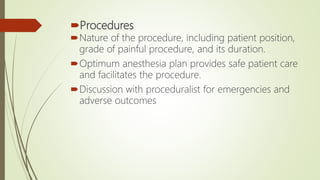NON OPERATING ROOM ANAESTHESIA
- 1. NON OPERATING ROOM ANAESTHESIA Presentor: Dr Kundan Kishor Ghimire Resident Anaesthesia and Critical Care Moderator: Dr. Dhiraj Kesari
- 2. Introduction Encompasses all sedation and anaesthesia provided by anesthesiology services outside of the operating room environment. Area remote from main operating room Radiology Department Endoscopy suites MRI Dental Clinics
- 3. Three step approach to NORA
- 4. Patients Most Patients tend to be older. (>50 yrs) receive monitored anesthesia care (MAC) or sedation Children commonly require sedation or anesthesia diagnostic and therapeutic procedures. thorough preanesthetic assessment, standard preanesthetic care. sound anesthetic plan with approppriate level of monitoring and appropriate postanesthetic care.
- 5. Patient factors requiring Sedation or Anesthesia for Nonoperating Room
- 6. Procedures Nature of the procedure, including patient position, grade of painful procedure, and its duration. Optimum anesthesia plan provides safe patient care and facilitates the procedure. Discussion with proceduralist for emergencies and adverse outcomes
- 8. ASA guidelines for non-operating room anesthesizing locations. Reliable O2 source with backup supply Suction apparatus Waste gas scavenging Self-inflating resuscitation bag. Adequate monitoring equipments Safe electrical outlets for emergency power supply Adequate illumination, battery backup Sufficient space for anaesthesia personnel, equipment Emergency cart, defibrillator, drugs, etc Reliable means for two-way communication Applicable facility, safety codes met Appropriate postanaesthetic management.
- 9. Patient Transfer Sick, unstable patients are transferred back and forth between ICU, OR and NOR locations for imaging, or diagnostic procedures. Skilled personnel to evaluate, monitor and support he medical condition. Portable ventilators and adequate suppies of oxygen Manual self inflating bag Anesthetic and emergency drugs, equipment for intubation intubation, portable suctions
- 11. Problems in providing NORA Equipment might be old, not regularly serviced and not in standard use as in the rest of the hospital Monitoring standards may not adequate. Piped gases may not be supplied. Other personnel may be unaware of the problems facing the anesthetist. Space may be limited by bulky equipment making access to patient difficult. Poor environment conditions( e.g. Lightening, temperature) Recovery facilities may not be available. Inadequate ventilation/ scavenging causing pollution. Problems related to transferring patients.
- 12. Definition of general anesthesia and levels of sedation/Analgesia
- 13. Environmental consideration for NORA X ray & Fluoroscopy C arm moves back & forth takes large space &means of dislodging IV and ETT. so, limit the time of exposure to radiation increase the distance from source or radiation. (> or < according to inverse square of distance from source) use protective shielding using dosimeters ( limit of 50 mSv in any year & lifetime limit of 10 mSv multiply age in year.
- 14. IV CONTRAST AGENTS Are iodinated compounds MRI contrast are ionic & nonionic. chelated metal containg gadolinium , iron , manganese. Renal CIN (contrast induced nephropathy) increase S.Creatinine of 0.5mg/dl or 25% from baseline within 48 hrs to 72 hrs.
- 15. Risk factor for CIN Renal disease Prior renal surgery Proteinuria DM HTN Gout
- 16. Hypersensitivity to contrast media
- 17. Magnetic Resonance Imaging a noninvasive diagnostic technique that uses magnetic properties of atomic nuclei to produce high-resolution, multiplanar cross-sectional images of the body. Strong magnetic field of 0.5-3.0 tesla. So ferromagnetic materials should be excluded from the area of magnet.
- 18. Implantable medical devices: pacemakers, vascular clips, automatic implantable cardioverter-defribillators, mechanical heart valves. Radiofrequency noise: sound >85db from MRI scanners
- 19. Choice of anesthetic technique depends upon patient’s comorbidities, duration, practioner preference and patient requirements. Deep sedation or GA with intubation or supraglottic airways. Sedation with oral route benzodiazepines or as intravenous sedation or MAC.
- 20. Small infants: ” feed, wrap, and scan” Oral chloral hydrate: 80-100mg/kg 30-60 min before procedure. Rectally administered barbiturates or General anesthesia with propofol, ketamine or inhaled anesthetics
- 21. Thank you





















